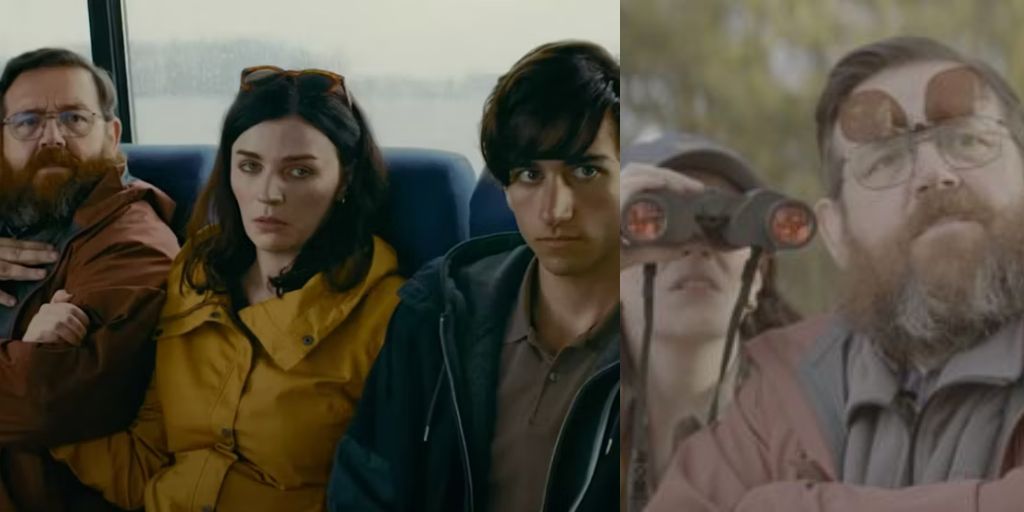In the spirit of Midsommar and Sightseers, Steffen Haars’ film Get Away turns a vacation into a nightmare. Nick Frost, who writes and stars in the movie, presents a Nordic view of tourism that mixes humor with shocking violence. The story begins with a family that hopes an island trip will lift their spirits.
They use funny, sitcom-like conversations, but these moments hide darker truths. Frost’s screenplay tests the audience’s patience, using comedy as a cover before revealing a dark twist that shocks even more because of its contrasting buildup.
What Is Get Away About?
Haars introduces us to the Smith family: “Daddy” Richard (Frost), “Mommy” Susan (Aisling Bea), huffy sister Jessie (Maisie Ayres), and snippy brother Sam (Sebastian Croft). They are heading to the Swedish island of Svälta during Karantan celebrations, which includes a long stage play.
When they arrive, they face cold treatment from everyone except their creepy rental homeowner (played by Eero Milonoff).
The Smiths are seen as intruders during Svälta’s remembrance of a cruel British quarantine that led to the suffering of many locals and their turn to cannibalism. While the islanders perform scenes and carry out traditions, the Smiths focus on having fun and bonding as a family.
Frost shows the Smiths as a typical family, but with an English twist. Richard is an anxious father who wears sweaters and lets his wife handle arguments. Susan shares facts like a tour guide and wants to be charming with her husband. If Get Away feels like a special episode of Modern Family set abroad, that’s by design.
Frost’s screenplay does not rely on clichés. There’s a reason he and Haars want you to feel a certain way about Richard’s dorky behavior or Jessie’s typical rebelliousness. Trust that clever writing makes you roll your eyes as the Smiths stick out in Svälta.
Get Away resembles Ben Wheatley’s Turistas or Girls With Balls for a while. The townsfolk show quick hostility toward the Smiths during their sacred rituals, leading to tension between outsiders and locals. Animal and insect costumes used during Karantan symbolize the locals’ resistance.
The Smiths face traditional scare tactics like torch-wielding mobs and strange gifts of animal carcasses. Anitta Suikkari’s character, an elder from Svältan, looks down on the Smiths, acting as an antagonist who wants to keep the old practices alive.
Her strange appearance gives a horror vibe, reminding us of folkloric tales where unsuspecting visitors go to the wrong place. She enjoys making the Smiths feel unwelcome, standing in stark contrast to Richard’s sad optimism, which dies before any real danger appears.
Get Away Is Fun, Crazy, and Builds to a Violent Ending
Haars knows how to handle the silliness of the first two acts, setting up the thrilling ending well. Frost’s script includes childhood memories from Finland that inspired Get Away, offering thoughts on both sides of the tourism debate.
The judgments about vacationers can be fair since locals often have to deal with outsiders who take over their land. But sometimes, locals hold biases against outsiders for simply being there.
Haars and Frost find funny ways to tackle these ideas, but then the third act changes everything. Svälta becomes a bloody scene with shocking outcomes, showing that filmmakers know the value of good pacing.
Once Iron Maiden’s “Run to the Hills” plays, Get Away speeds up. The film is filled with decapitations, impalements, and splattering blood as it turns into a fight for survival. Special effects teams have fun creating body parts, making the island a battlefield.
This is not just a typical action-horror film like The Night Comes for Us, as it relies more on dark humor than smooth fight scenes. But what we see is still a wild ride filled with excitement. Maybe there could be a shorter version that gets to the bloody chaos quicker, but as it stands, Haars and Frost succeed in taking bold risks with their storytelling.
Get Away is a surprising joyride that uses vacationer stereotypes to hide deeper, darker themes. The simple setting of Svälta feels real, from its rich history to its cozy waffle huts, while the Smiths act as polite yet annoying visitors.
Haars excels as a comedy director, so the horror elements never fully come to light — but that’s okay because Frost’s script is genuinely funny, reminiscent of Edgar Wright’s style. From beginning to end, the Smith family shines against the more rigid local characters. Though reaching the climax takes time, Get Away is a fun stop for horror fans.
Get Away premiered at the 2024 Fantastic Fest. It will hit theaters on December 6.




